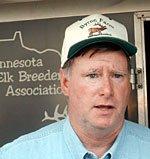By Tom Scheck
Minnesota Public Radio
August 30, 2002
State officials have confirmed Minnesota's first case of chronic wasting disease. The disease was discovered in a domestic elk raised on an Aitkin County farm. The state Board of Animal Health says it has quarantined the farm. Chronic wasting diseases is an incurable, fatal brain and nervous system disease that's found in elk, moose, deer and caribou. State officials say they'll test the deer population near the farm to determine whether it has spread beyond the elk.
| |
|
|
|
||
The state Board of Animal Health says a five-year-old male elk tested positive for chronic wasting disease after dying on Aug. 15. Officials wouldn't say which elk farm was quarantined but said the owners own 48 other elk and no other animals.
Paul Anderson, a veterinarian with the board, says all of the animals are quarantined in a fenced-in pasture. He says the owners bought the infected elk from a Stearns County farm. He says officials are considering a quarantine at that farm as well. The Aitkin County farm is the 23rd elk farm in the nation to be contaminated with CWD.
Anderson says in most of the other cases, the entire herd was destroyed. "Investigations are underway currently to determine the source of the infection and to determine if any other animals may have been exposed," he said.
Anderson says it may also be necessary to destroy the herd on the Aitkin County farm. CWD has been found in eight states and in Canada. Anderson says health officials don't fully understand how the disease is transmitted. He says humans and livestock can't get, CWD but it does spread among certain other animals.
However, other scientists say more research is needed before declaring with certainty the disease cannot communicate to humans. The Centers for Disease Control in Atlanta is investigating the deaths of three men who died from neurological diseases. The deaths of two Wisconsin men and one Minnesota man, all big game hunters, have caused concern that CWD has jumped to humans.
CWD has also turned up in wild deer herds in Wisconsin. Officials in that state have initiated a kill of 25,000 deer to stop it from spreading.
Mike DonCarlos, with the Minnesota Department of Natural Resources, says they'll kill at least 100 deer in the Aitkin County area to test whether CWD has to them.
| |
|
|
|
||
"Chronic wasting disease has the potential to significantly reduce deer populations over a lengthy period of time and that's why we're concerned about it. Exactly how it would play out in the deer herd, we're not sure," he said.
The DNR has not placed any restrictions on deer hunting season. However, the DNR is asking hunters not to feed wild deer with salt blocks or mineral blocks this season.
DonCarlos says they'll also move forward with earlier plans to test 5,000 deer for CWD in November. Deer hunting is a $250-million-a-year industry in the state.
"It probably will show up at some time in the wild deer population," predicts Mark Johnson with the Minnesota Deer Hunters Association. He says he isn't surprised by the discovery of CWD in Aitkin County since it has been found in wild deer in Wisconsin. While eating venison is safe, Johnson says concerned hunters should not eat meat from an animal that appears sick. He also says they also shouldn't eat the brain, spinal column, tonsils and lymph nodes.
"Hunting is the primary management tool for white tail deer. And without hunters the number of deer that will be harvested will not be nearly what it should be," he said.
CWD could pose a serious risk to the state's domestic elk farms. Minnesota is one of the national leaders in the number of domestic elk farms. Anderson, with the board of animal health, says it's likely several states will halt importation of Minnesota elk because of the CWD threat.
Jim Byrne, the vice president of the Minnesota Elk Breeders' Association, says his members will cope with chronic wasting disease.
"We'll deal with it just as we have dealt with animal health issues before. We've dealt with TB when that was an import here about eight or 10 years ago. We've eradicated that from the state herds and we'll make sure that this is eradicated from our herds in Minnesota," Byrne said.
Two-hundred-eight-eight elk and deer farms have registered with the Minnesota Board of Animal Health and most participate in the chronic wasting disease testing program. However, herd owners can register with other state agencies. Officials with the DNR say they'll ask the Legislature to create one monitoring system under the board of animal health. Officials with the Elk Breeders' Association say they'll support that measure.
More Information

